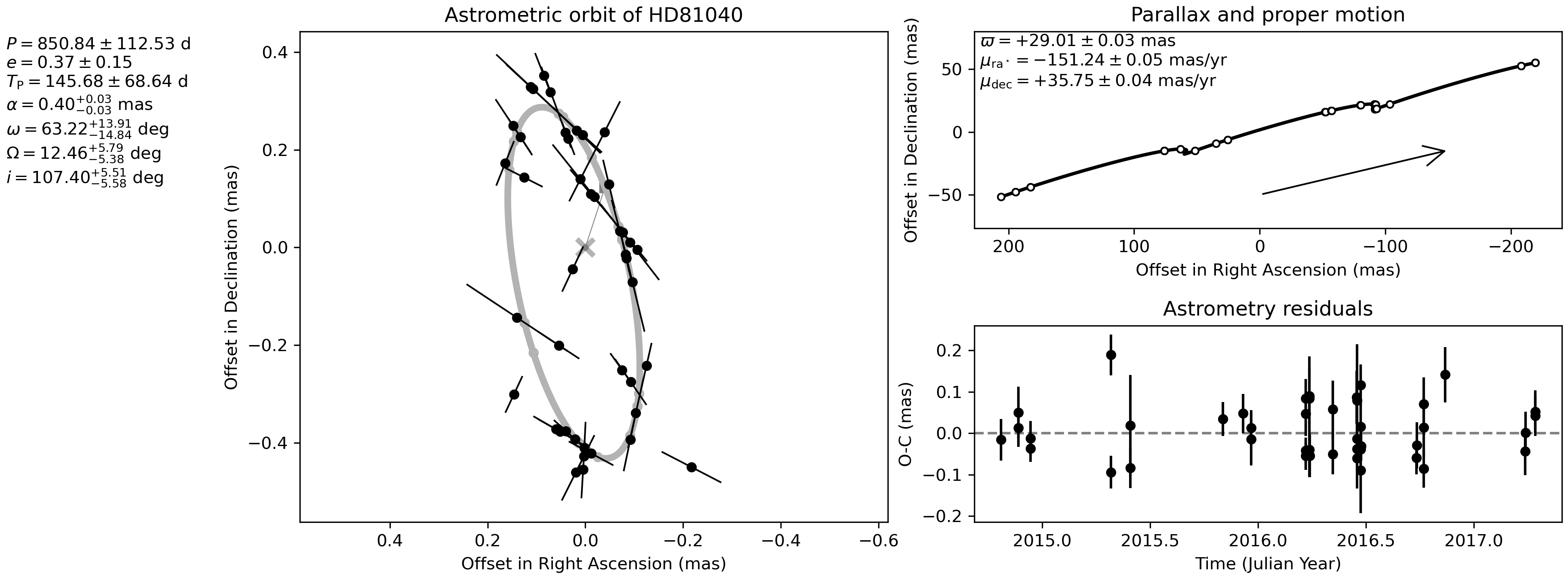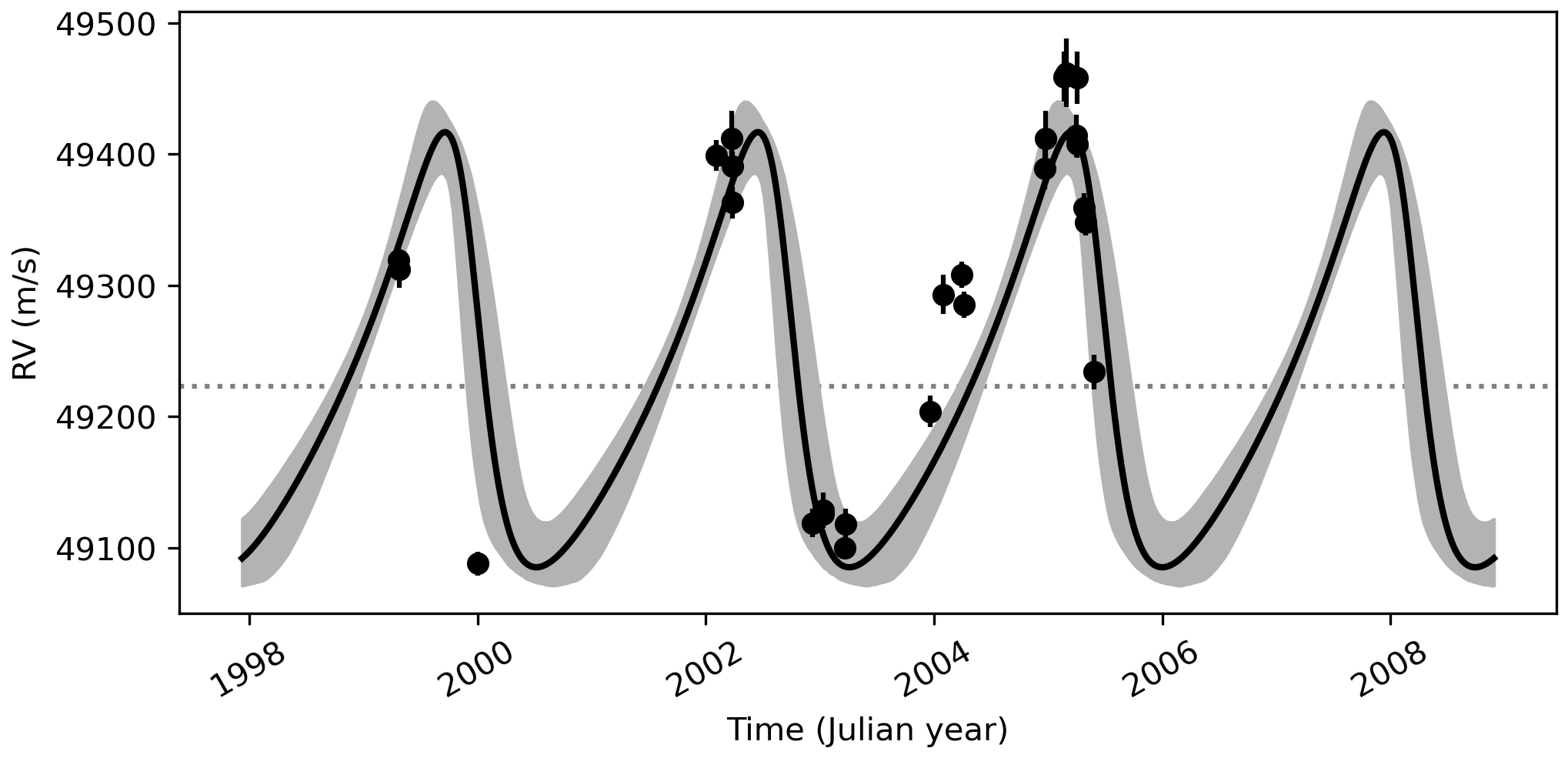IoW_20220131 - Gaia
Image of the Week
Astrometric orbit of the exoplanet-host star HD81040
Figure 1: Astrometric orbit of HD81040 (left panel) as determined by Gaia. North is up and East is left. The sky-projected orbit model about the system barycentre marked with an "x" is shown in grey and astrometric normal-points after subtraction of parallax and proper motion are shown in black. Only one-dimensional ("along-scan") astrometry was used, therefore the shown offsets are projected along Gaia's instantaneous scan angle, whose orientation is also indicated by the error-bars. The star's modelled parallax and proper motion is shown in the top-right panel by the solid curve, where open circles indicate the times when the star crossed the Gaia field-of-view. The arrow indicates the direction of motion. The bottom right panel shows the post-fit residual normal-points, whose small root-mean-square disperson of 65 micro-arcsecond indicates that the chosen astrometric model reproduces the data well. Normal-points are computed at every field-of-view transit of the star from the ~9 individual CCD transits and are only used for visualisation, whereas the data processing uses individual CCD-transit data. The solution parameters and their uncertainties are shown by insets on the very left and in the top right panel. Credit: ESA/Gaia/DPAC, CC BY-SA 3.0 IGO.
Many exoplanets are known to orbit stars in the solar neighbourhood but for only a few it was so far possible to measure the tiny corresponding motion of the host star in the plane of the sky. And when it has been achieved, e.g. with the Hubble Space Telescope (McArthur et al. 2010), the Very Large Telescope (Sahlmann et al. 2016), or Very Long Baseline Interferometry (Curiel et al. 2020), it required significant investments in terms of observing resources and the researchers' ingenuity and perseverance.
In contrast, Gaia automatically delivers measurements of non-single stars because those are being observed just as any other source in the sky, and Gaia's astrometric precision is often sufficient to detect the signatures of orbital motion caused by giant exoplanets. When the orbital period is comparable to the time span of Gaia's observations the planet's tug on the star can become apparent as an excess displacement on top of the stellar parallax and proper motion.
The robust detection of astrometric orbits requires a sufficiently large timespan and dedicated processing steps, which is why non-single star solutions have so far been absent from Gaia data releases. This will change dramatically with the upcoming third data release which will contain hundreds of thousands of non-single star solutions, from astrometry, photometry, and spectroscopy.
Figure 1 shows the orbital solution, to be released in Gaia DR3, for the bright (G
In 2006, radial-velocity variations of HD81040 revealed the presence of a super-Jupiter planet orbiting the star every 1000 days (Sozzetti et al. 2006). Comparison of the orbital parameters in common between the radial-velocity and astrometry solutions shows that Gaia has independently detected the star's reflex motion caused by the same orbiting planet. Since Gaia is observing in a visible bandpass and this system is not young, we can safely assume that the light contribution by the planet is negligible, hence the orbits of the star and the system's photocentre coincide. As expected, that orbital motion is tiny and has a semi-amplitude of ~0.4 mas, i.e. about 3 orders of magnitude smaller that the star's annual proper motion. To give a sense of absolute scale, an astronaut's footprint on the moon as seen from Earth corresponds to about half of the angular orbit size.
The astrometric period is about 150 days (~1.3
Figure 2: The radial-velocity curve of HD81040 predicted by the Gaia astrometry solution (black curve, offset by the systemic velocity) and the measured radial velocities from Sozzetti et al. 2006 (black symbols). Because the radial-velocity period is much more precise and the radial-velocity data were taken >10 years before the Gaia data, the radial-velocity period was used for the purpose of this figure. The grey region shows the 1-
Since the Gaia astrometry determined the orbital inclination, we can resolve the sin i ambiguity of the radial-velocity solution and determine the actual planet mass of 8.04-0.54+0.66 MJupiter, which is roughly one Jupiter-mass higher than the lower limit from radial-velocities. The given uncertainties were computed using Monte-Carlo resampling and take into account all solution parameter uncertainties and covariances.
Recently, the astrometric orbit of HD81040 was also constrained by combining the available radial velocities with the change in absolute proper motions between Hipparcos and Gaia EDR3 (Li et al. 2021). Their solution parameters are generally in good agreement with the Gaia orbit from epoch astrometry, except for the ascending node, which is not very well constrained by their solution. The inclination bimodality in the Li et al. solution is resolved by the Gaia orbit, which unambiguously establishes the retrograde configuration (i > 90 deg) as being the correct one.
This orbital solution is part of the first long-awaited results on exoplanets from Gaia. It is a small appetiser for a larger sample of astrometric orbits that will be released in Gaia DR3. We stress that no epoch astrometry will be released in Gaia DR3, i.e. the data points shown in Figure 1 will generally not become publicly available before Gaia DR4.
Whereas Gaia's data release 3 was generated from the first 34 months of data, Gaia is now in the eighth year of science operations and its astrometry will eventually lead to the discovery and characterisation of thousands of giant exoplanets and substellar companions orbiting nearby stars (e.g. Perryman et al. 2014, Sozzetti et al. 2014, Holl et al. 2021). This will make it possible to investigate the masses and orbital architectures of exoplanetary systems on a large scale and explore the dynamics of multi-planet systems and circumbinary planets.
Gaia's data release is expected in the second quarter of 2022. More information on Gaia's future releases can be found from the Gaia release scenario page.
Credits: ESA/Gaia/DPAC/CU4-CU3, Johannes Sahlmann (RHEA Group for ESA, ESAC); members of Development Unit 437 (Extrasolar planets): Berry Holl, Damien Ségransan, Domenico Barbato, Jean-Baptiste Deslisle, Nicolas Unger (University of Geneva), Alessandro Sozzetti, Paolo Giacobbe, Mario G. Lattanzi (INAF - Osservatorio Astrofisico di Torino); the CU4/NSS team; the CU3 teams.
Published: 31/01/2022
- Removed a total of (8) style text-align:center;
- Removed a total of (3) style text-align:justify;
- Removed a total of (2) style margin:0;
Image of the Week Archive
- Removed a total of (1) border attribute.
- Removed a total of (1) cellpadding attribute.
- Removed a total of (1) cellspacing attribute.








































 Sign in
Sign in
 Science & Technology
Science & Technology

